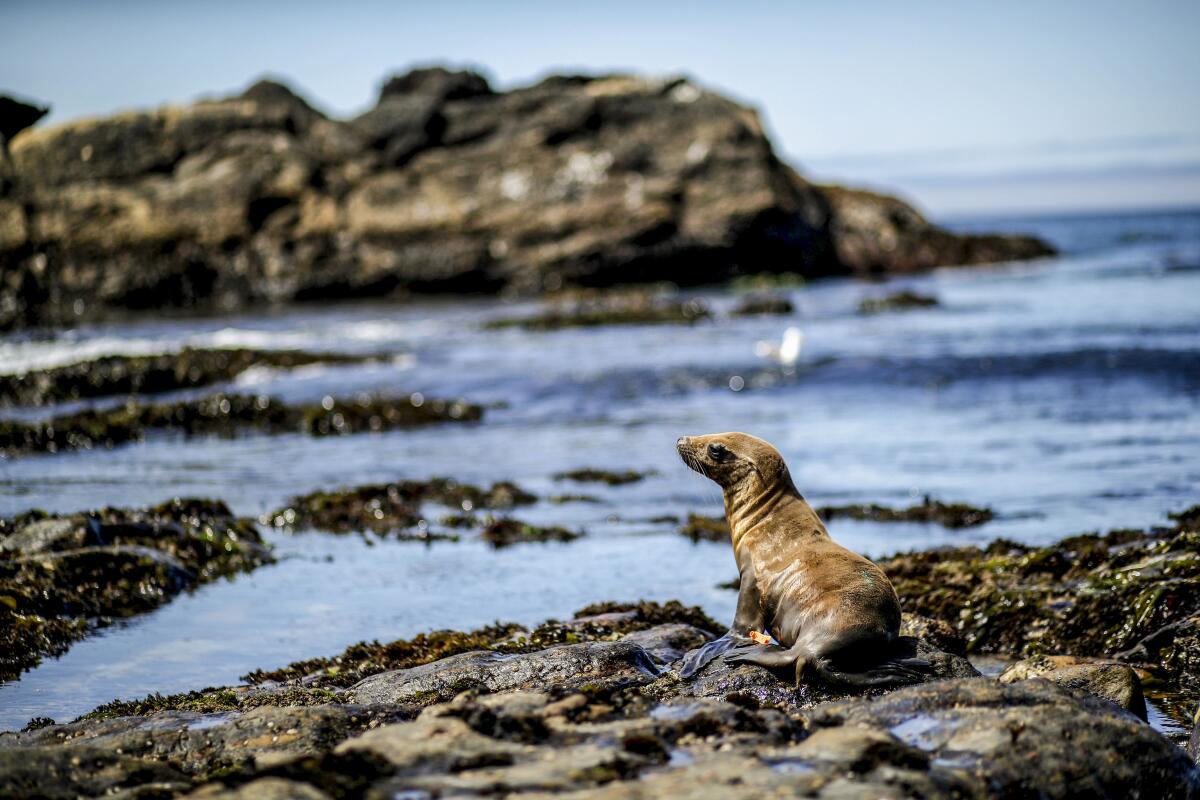These are the ‘hot spots’ in California for seal, sea lion harassment

- Share via
Juicebox, a northern fur seal pup, had been attacked by an off-leash dog in San Francisco’s Ocean Beach when marine mammal rescuers found him in October.
A starving harbor seal pup named Sionna was found last April at Bolinas Beach in Marin County after she was separated from her mother and placed on a surfboard.
Snowcone, a harbor seal pup that was likely still nursing, was separated from its mother by two beachgoers at Shell Beach in Sonoma County last April. He did not survive.
The Marine Mammal Center, a nonprofit animal research hospital that oversees 600 miles of the California coast, recently released a report listing “hot spots” where numerous marine mammals were harassed by people last year.
More than 25% of its animal patients were admitted due to negative interactions with people and dogs — highlighting the impacts of human interference in wildlife, according to researchers.
“Put simply: We’re getting too close,” said Giancarlo Rulli, a spokesperson for the Marine Mammal Center. “In some circumstances, we are literally loving these marine mammals to death.”
The Sausalito-based center covers the coast from Mendocino to San Luis Obispo counties. California sea lions, Northern Elephant Seals, and Pacific harbor seals are the center’s most common patients.
Seals and sea lions are protected under the Marine Mammal Protection Act, which prohibits the harassment, hunting, capturing and killing of these animals.
“Taking that once-in-a-lifetime shot or selfie may seem cute or innocent, but it creates challenges for marine mammals, especially young seals and sea lions,” Rulli said.
The areas with the highest recorded cases of human wildlife interference were Santa Cruz and Monterey counties, which accounted for about 40% of the center’s admitted patients last year, Rulli said. But that’s not too surprising, he added.
“Monterey Bay is like a sea cafeteria,” Rulli said. “There’s ecological bounty in the area for numerous marine mammal species, but it’s also a very busy tourist area along our coast.”
Other hotspots along the coast included San Luis Obispo with 18% of harassment incidents, San Mateo with 13%, and San Francisco with 8% of the recorded cases last year.
Crowding was the most common type of harassment followed by touching and picking up, which made up about 35% of all cases. Incidents were equally common during the spring pupping season and in summer, researchers said.
Although the overall number of cases were fewer in the Bay Area than in the Central Coast, incidents up north were found to be more more severe, according to the report. In Marin County, researchers noted more cases of illegal pickups of harbor seal pups. Human and dog interactions with young seals and sea lions were recorded in high numbers in San Francisco and San Mateo counties.
Rulli said it’s the first time the center has collected this kind of data, and researchers plan to use it as a baseline to track marine mammal health and address behavioral issues related to human wildlife interaction.
“We are very lucky that we can go to many places along the California coast and view wildlife up close. But with that comes increased responsibility on our part to share the shore with these animals,” Rulli said.
In Los Angeles County, the Marine Mammal Care Center rescues, rehabilitates and releases injured animals along the coast and on Catalina Island. Though they have not collected data like their colleagues up north, CEO John Warner said they intend to start.
“For us, 25% would probably be an under report of what the numbers really are,” Warner said.
In sunny Los Angeles County, beaches are more populated with people and marine mammals are unable to comfortably rest on the shore, Warner said. He remembered incidents in which animals were dragged by the flippers, covered under blankets, or had sand thrown at them.
Biologists advise people to keep a safe distance from marine mammals on beaches and in the waters. If an animal reacts to you, then you are too close. Photography is fine, but “seal-fies” are not.
People who see a marine mammal in distress are asked to not approach them, but instead call the Marine Mammal Center’s hotline at 415-289-SEAL or in Los Angeles County call 800-39-WHALE.
More to Read
Sign up for Essential California
The most important California stories and recommendations in your inbox every morning.
You may occasionally receive promotional content from the Los Angeles Times.














